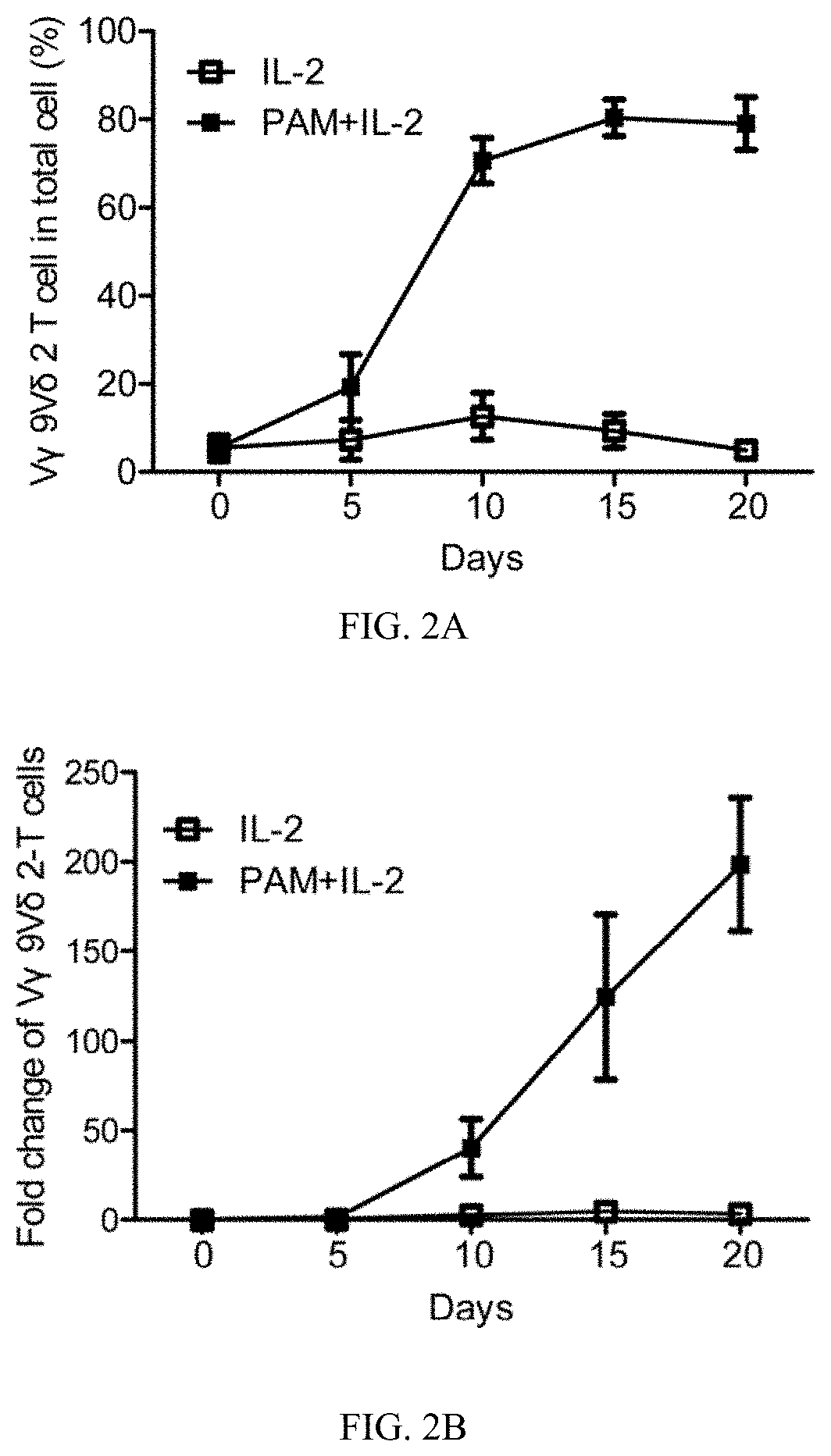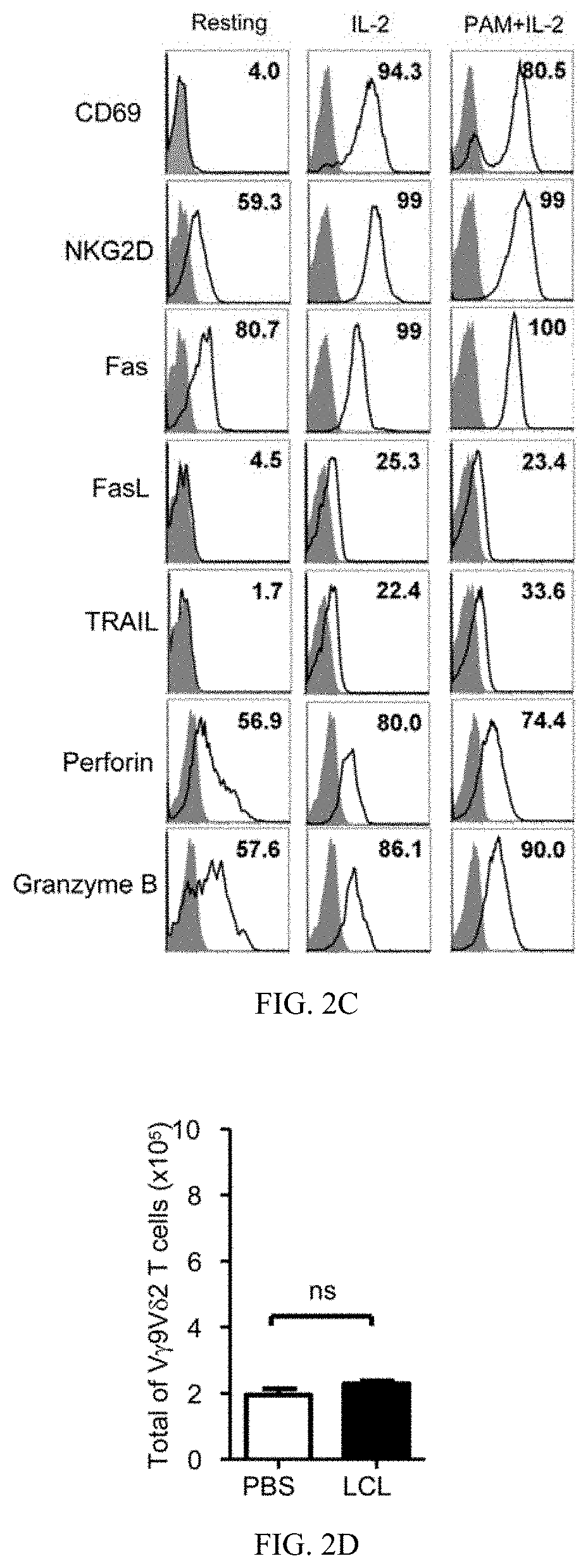Biophosphonate compounds and gamma delta T cell-mediated therapy for treating epstein-barr virus-associated disorders
a technology of epsteinbarr virus and gamma delta t cells, applied in the field of epsteinbarr virus-associated disorders, can solve the problems of high risk of ebv-induced b cell lymphoproliferative disorders (ebv-lpd), significant morbidity and mortality, and limited application for ebv-lpd treatment, and achieve the effect of reducing complications
- Summary
- Abstract
- Description
- Claims
- Application Information
AI Technical Summary
Benefits of technology
Problems solved by technology
Method used
Image
Examples
example 1
Vγ9Vδ2-T Cells Kill EBV-LCL In Vitro
[0115]EBV-LCL showed enhanced expression of stress-inducible major histocompatibility complex class I-related proteins A and B (MICA / B), Fas and TNF-related apoptosis-inducing ligand (TRAIL) receptor 2 (DR5) expression, when compared to their normal autologous B cells (FIG. 1A). In contrast, both normal B cells and EBV-LCL had little or no FasL and TRAIL receptor 1 (DR4) expression on cell surface (FIG. 1A). Consistent with our previous reports (Li et al., 2013; Tu et al., 2011), pamidronate induced selective activation and expansion of Vγ9Vδ2-T cells, and up-regulation of the surface expressions of CD69, NKG2D, Fas ligand (FasL), TRAIL, and intracellular cytolytic granules, perforin and granzyme B, in Vγ9Vδ2-T cells (FIG. 2A-2C). In contrast, EBV-LCL alone could not efficiently expand Vγ9Vδ2-T cells from EBV-seropositive donors (FIG. 2D).
[0116]Pamidronate-expanded Vγ9Vδ2-T cells were purified by positive or negative selection with anti-TCRγ / δ Mic...
example 2
Vγ9V82 T Cells Prevent EBV-LPD in Rag2− / −γc− / − Mice
[0119]Human B cells infected with the EGFP-tagged EBV were used to establish EGFP+ EBV-LCL in order to monitor the growth of EBV-LCLs in vivo. The EBV-LPD model was further established in the Rag2− / −γc− / − immunodeficient mice after subcutaneous (s.c.) inoculation of EGFP-expressing EBV-LCL (0.1×106 / mouse) (FIG. 3A) (Lacerda et al., 1996). To determine whether human Vγ9Vδ2-T cells could prevent EBV-LPD in vivo, highly purified (>97%) pamidronate-expanded autologous Vγ9Vδ2-T cells (10×106 cells / mouse) were adoptively transferred intravenously (i.v.) into Rag2− / −γc− / − mice at day 0, 7, 14 and 21 post EGFP-expressing EBV-LCL inoculation (FIG. 3A). PBS-treated mice were used as controls.
[0120]After inoculation with EBV-LCL, all control mice developed EBV-LPD. The rapid growth of EBV-LCL was detected subcutaneously in PBS-treated mice by in vivo imaging after inoculation with EBV-LCL, and all control mice developed subcutaneous solid tumo...
example 3
Vγ9Vδ2-T Cells Induce the Regression of EBV-LPD in Tumor-Bearing Rag2− / −γc− / − Mice
[0122]To determine whether Vγ9Vδ2 T cells have therapeutic effect on EBV-LPD in mice, EGFP-expressing EBV-LCL (0.1×106 / mouse) were inoculated into Rag2− / −γc− / − mice s.c. (FIG. 5A). Twenty one days later, all the mice had developed large subcutaneous tumors (medium surface area, 137 mm2) as detected by in vivo imaging (FIG. 5B). Then half of these tumor-bearing mice were adoptively transferred with highly purified pamidronate-expanded autologous Vγ9Vδ2-T cells (10×106 cells / mouse) i.v. at day 21, 28, 35 and 42, and another half of these tumor-bearing mice were treated with PBS as the control (FIG. 5A). PBS-treated mice had subcutaneous tumor with progressive growth and extension to the abdominal cavity, liver and kidney (data not shown), ultimately causing death within 43 days after EBV-LCL inoculation (FIG. 5B-5C). In contrast, Vγ9Vδ2-T-cell treatment constrained tumor growth, and only 1 of 6 mice died...
PUM
| Property | Measurement | Unit |
|---|---|---|
| time | aaaaa | aaaaa |
| concentration | aaaaa | aaaaa |
| diameter | aaaaa | aaaaa |
Abstract
Description
Claims
Application Information
 Login to View More
Login to View More - R&D
- Intellectual Property
- Life Sciences
- Materials
- Tech Scout
- Unparalleled Data Quality
- Higher Quality Content
- 60% Fewer Hallucinations
Browse by: Latest US Patents, China's latest patents, Technical Efficacy Thesaurus, Application Domain, Technology Topic, Popular Technical Reports.
© 2025 PatSnap. All rights reserved.Legal|Privacy policy|Modern Slavery Act Transparency Statement|Sitemap|About US| Contact US: help@patsnap.com



